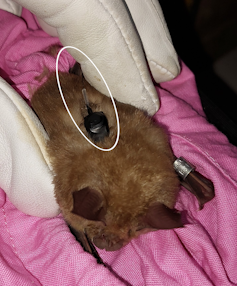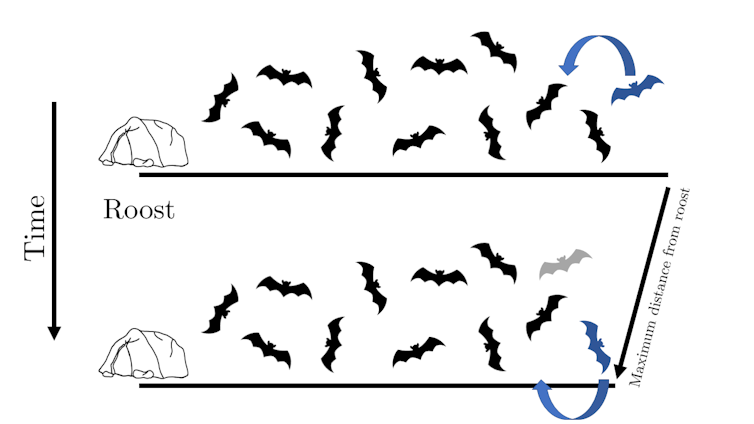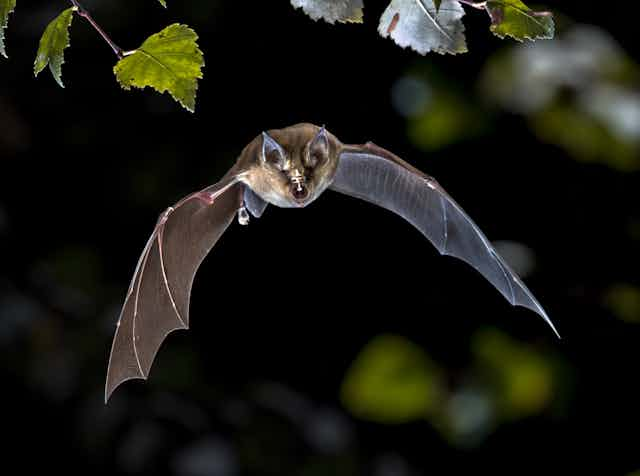A silent ballet takes place above our heads at night as Britain’s bat populations leave their roosts to forage for food. Although their initial movement away from roosts is fairly well understood, until recently little was known about how they returned home.
But our new research shows how bats may use a “leap-frogging” motion to make their way home, something which could help conservationists in future.
As they flit through the darkness, bats play a crucial role in the health of our ecosystems. From keeping insect populations in check to dispersing seeds and pollinating plants, they provide a multitude of benefits.
In the UK alone, the 18 bat species devour agricultural pests such as cockchafers with impressive efficiency. So, it is imperative that we not only understand and appreciate bats, but also actively support and safeguard their populations for the wellbeing of our planet.
But bat populations are vulnerable to pollution, climate change and loss of roosting locations. Habitat fragmentation and light pollution can also interrupt how bats feed. This is particularly important during the maternity season in early summer, when bats gather together to have and raise their young.
An integral aspect of effective bat conservation lies in unravelling the mysteries of how bats move. This not only helps us understand how bats navigate and use their environment, but also helps in identifying and protecting their roosts.
Radio-tracking
Conventional methods for pinpointing bat roosts primarily hinge on radio-tracking surveys. This arduous process involves capturing bats, attaching small radio transmitters to them before releasing them and following the signals throughout the night.

Our team conducted a radio-tracking survey in Devon which monitored 12 greater horseshoe bats over 24 nights. The trajectories of seven of those bats over 14 nights were extracted from the data for analysis, ensuring that in each case, a bat’s beginning and ending roost were the same.
Using this data, we measured the population’s average distance from the roost. We found two distinctive patterns in the data we analysed: an initial spread of bats within the first one to two hours after sunset and a gradual return to the roost afterwards.
The initial spread reflects the expected random dispersal of bats leaving their roosts to forage after sunset. The return to the roost, occurring two to eight hours after sunset, is more complicated.
This prompted us to explore two potential mechanisms influencing the bats’ return. First, a “pull mechanism”, where the roost attracts the bats home, and second, a mechanism pushing the bats who range furthest away back to the roost.
We modelled the pushing mechanism as a leapfrog process. Imagine this as a cascade effect, where the outermost bats begin their return. Once the “outer” bats have passed or “leapt over” bats that are closer to the roost, the “inner” bats become the furthest out causing them to return too.
This motion unfolds systematically, like a synchronised dance, as each bat from the periphery of the foraging range follows suit in returning to the roost after being “leapfrogged”.

But what causes the bats to return in this manner? One plausible explanation underscores how bats rely on each other for effective navigation, like tiny radar signals. If a bat experiences prolonged silence or predominantly hears calls from one direction, it might decide to move closer to the roost, anticipating the presence of other colony members.
But a bat might return more slowly, prolonging foraging, if it perceives the presence of bats beyond its current location. So, it is the outer bats that would drive the return as they would not be surrounded by calls.
How does this research help bats?
The significance of these findings extends beyond just describing the movements of bats. They have laid the foundation for work that promises easier discovery of new bat roosts, potentially reducing the need for labour-intensive bat tracking surveys in the future.
One of the immediate effects of our research includes informing a measurement of the “core sustenance zone” for greater horseshoe bats. This is where most of their foraging occurs, so it’s important in bat ecology, conservation and construction planning.
The leapfrogging mechanism also allows us to ascribe intention to bat movements. Namely, through using surrounding bat calls they can identify where the population is relative to their position, suggesting whether or not they are on the periphery of the group, which is an indicator of their vulnerability. Should they be furthest from the roost they move back towards the bulk of the population and closer to the roost.
While these interpretations hold promise, further rigorous testing is essential. And we need to think about the safety and wellbeing of the bat population.
Our observations are also specific to greater horseshoe bats during the summer months. Different bat species have distinct flight patterns and habitat preferences, with the same species displaying diverse behaviours at different times of the year.
So, while we have taken some crucial first steps, we still have a lot of work to do in unravelling the characteristics of bat motions in general.

